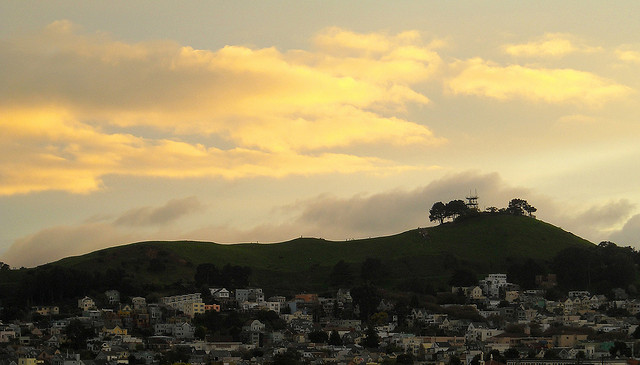Bernal Heights – The Hills of San Francisco Part II

Part I can be found here.
Bernal Heights is a prominent landmark on the eastern side of San Francisco. Rising south of the Mission District, its 433 foot peak is the second highest in the eastern part of San Francisco, exceeded only by Candlestick Heights in the southeast corner of the City (1). The open space and radio tower on its peak also make it easily recognizable. Like most hills in the City, Bernal Heights is also a neighborhood, as much defined by its natural environment as by its residents.
Like other San Francisco hills that have preserved open spaces, Bernal has retained many natural characteristics. Its upper reaches display a typical but little seen example of San Francisco natural history. Over the eons, fine particles of soil have blown onto ribbon patterned outcrops of Franciscan radiolarian chert and turned these rocks a distinctive red (2). Among the open space’s grasses, California poppies and other wildflowers also grow. In the rainy season, shaded areas on the Heights support ferns. Native plants such as coyote bush, willow and elderberries are found along with introduced species such as Himalayan blackberry, pines and eucalyptus. Most of the grasses are also non-native and neighborhood volunteers work to reduce the range of the invasive species. Still, some non-natives add to the outdoor ambience of the neighborhood. Residents often pick blackberries while tall pine and eucalyptus trees provide shade and beauty. Animals also live on the hill though somewhat warily. Raccoons, opossums, endangered San Francisco garter snakes and at least one coyote have been seen on Bernal. Stellar jays, songbirds and hummingbirds fly among the brush while kestrels and hawks patrol the sky looking for gophers, field mice and other rodents.
This natural setting of hawks soaring above a landscape of chert and coyote bush helps give the neighborhood below a small town feel. Except where Mission Street trudges along its western shoulder, there are only two stoplights – both on the lower foot of the northern slope. Bernal’s two largest buildings are St. Kevin’s Roman Catholic Church and the public library. Community gardens and mini-parks are found all over the heights and the hilltop is a favorite dog walking spot. Compared to most parts of San Francisco, Bernal Heights is so family friendly that it is often nicknamed “Maternal Heights” (3).
This pastoral feeling is guarded and enhanced by steep slopes. Parts of the eastern side are so steep that no streets have been built there. And in a city famed for its steep streets, Bernal boasts the steepest. Four of San Francisco’s six steepest streets are on Bernal. The City’s 6th steepest is Ripley on Brenal’s north slope, where it rises east of Alabama at a staggering 31.5% grade. Two other Bernal streets are the City’s 3rd and 4th steepest streets. But it is Bradford Street north of Tompkins with its cardiac arresting – be careful or your front wheel may rise off the pavement – forty one per cent grade that is San Francisco’s steepest bike climb (4).
For many years, Bernal Heights was a well guarded secret among its residents who hope to keep the unique feel of their neighborhood. But with San Francisco’s population increasing to its highest level in history, every neighborhood including Bernal has seen its unique characteristics threatened by unrestrained development. So far, Bernal’s residents have retained most of the features that make their neighborhood so appealing. Hopefully, they always will.
- Wikipedia entry: “List of hills in San Francisco”
- www.foundsf.org/index.php?title=ROCKS
- www.sfgate.com/living/article/MUSINGS-Childless-in-Maternal-Heights-for-2497184.php An article in 2006 by Sasha Cagen
- www.datapointed.net/2010/02/more-steeps-of-san-francisco/ Stephen Von Worley, the researcher and aauthor of this website claims that Bradford is not only the steepest street in San Francisco; it is the steepest “urban thoroughfare” in the world.